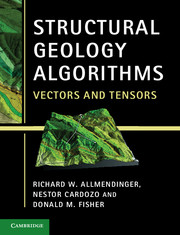Book contents
- Frontmatter
- Contents
- Preface
- Chapter One Problem solving in structural geology
- Chapter Two Coordinate systems, scalars, and vectors
- Chapter Three Transformations of coordinate axes and vectors
- Chapter Four Matrix operations and indicial notation
- Chapter Five Tensors
- Chapter Six Stress
- Chapter Seven Introduction to deformation
- Chapter Eight Infinitesimal strain
- Chapter Nine Finite strain
- Chapter Ten Progressive strain histories and kinematics
- Chapter Eleven Velocity description of deformation
- Chapter Twelve Error analysis
- References
- Index
Chapter Two - Coordinate systems, scalars, and vectors
Published online by Cambridge University Press: 05 June 2012
- Frontmatter
- Contents
- Preface
- Chapter One Problem solving in structural geology
- Chapter Two Coordinate systems, scalars, and vectors
- Chapter Three Transformations of coordinate axes and vectors
- Chapter Four Matrix operations and indicial notation
- Chapter Five Tensors
- Chapter Six Stress
- Chapter Seven Introduction to deformation
- Chapter Eight Infinitesimal strain
- Chapter Nine Finite strain
- Chapter Ten Progressive strain histories and kinematics
- Chapter Eleven Velocity description of deformation
- Chapter Twelve Error analysis
- References
- Index
Summary
Coordinate systems
Virtually everything we do in structural geology explicitly or implicitly involves a coordinate system. When we plot data on a map each point has a latitude, longitude, and elevation. Strike and dip of bedding are given in azimuth or quadrant with respect to north, south, east, and west and with respect to the horizontal surface of the Earth. In the western United States, samples may be located with respect to township and range. We may not realize it, but more informal coordinate systems are used as well, particularly in the field. The location of an observation or a sample may be described as “1.2 km from the northwest corner fence post and 3.5 km from the peak with an elevation of 3150 m at an elevation of 1687 m.”
A key aspect, but one that is commonly taken for granted, of all of these ways of reporting a location is that they are interchangeable. The sample that comes from near the fence post and the peak could just as easily be described by its latitude, longitude, and elevation or by its township, range, and elevation. Just because we change the way of reporting our coordinates (i.e., change our coordinate system), it does not mean that the physical location of the point in space has changed. This seems so simple as to be trivial, but we will see in Chapter 5 that this ability to change coordinate systems without changing the fundamental nature of what we are studying is essential to the concept of tensors.
- Type
- Chapter
- Information
- Structural Geology AlgorithmsVectors and Tensors, pp. 23 - 43Publisher: Cambridge University PressPrint publication year: 2011



